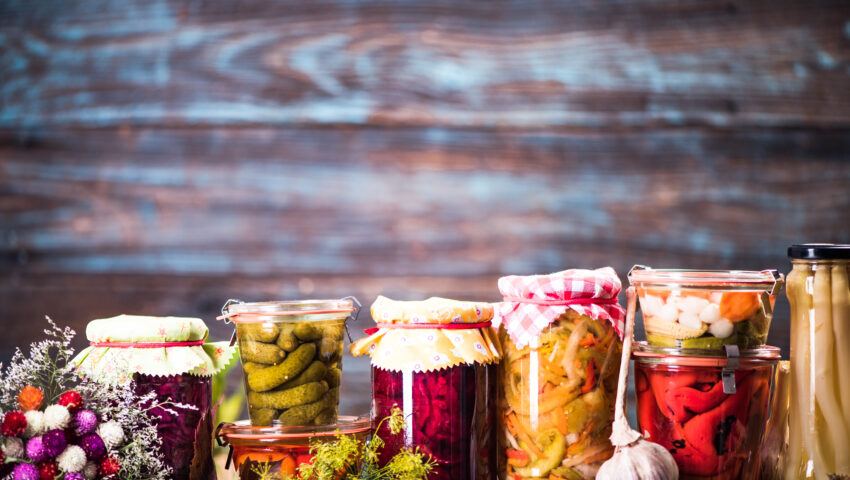Blogs
Fermentation and Pickling the bm way…

After last week’s blog, we looked in detail at chutneys and jams, which covered the cooking side of preserving. This week we have shifted our attention to how to fermentation and pickling, these can be words that drive fear into the hearts of many people! Especially as fermentation can be seen as a very technical task that you need specialist equipment for. This can be quite a challenge, however it is a largely unintimidating process that is extremely rewarding.
Fermentation
Fermentation has been one of the ‘buzz words used in the last few years in cooking and health circles. A form of preservation that had been used for hundreds of years has come back into popularity recently. Driven mainly by the purported health benefits that fermented foods are supposed to give. Sometimes we can forget just how many of our day to day favourite foods are fermented. Coffee, chocolate, bread, cheese and Tabasco sauce are all fermented foods.
What does fermentation do?
Think about a bag of lemons that you have bought from the shop, usually in pristine condition, unmarked with no blemishes. Leave it outside for a few days and you can see how fast the spoilage bacteria begins to work. The skin will wilt and mould might begin to show. After a few more days, it will spoil completely and become inedible.
Fermentation in its simplest explanation, is the control of that microbial growth using beneficial bacteria as a preservation tool. Lemons left in a brine or lightly salted solution will not go off, but slowly change and turn into preserved lemons that can be used in tagines and salads.
There are 3 mains forms of fermentation, but we will be focusing on Lacto-fermentation. Lactobacillus bacteria convert sugars that are naturally present in fruit or vegetables into lactic acid. Lactic acid is a natural preservative that helps fight bad bacteria and preserves not only the flavour and texture of food, but also the nutrients.
What fruit and vegetables to use?
The best fruit and vegetables to use are hard fruits and veg. Items like radishes, cabbage and carrots are great to preserve. Avoid gassy vegetables like broccoli. Soft vegetables like tomatoes are possible to ferment, but can be more difficult to do.
How to ferment
There are two main ways to start the process – one is to use a brine, which is essentially salted water as you would find in olives. The other method is to lightly salt fruit and vegetables and allow that to draw out the liquid and make its own brine, for example sauerkraut is made in this way.
A good rule of thumb for brining is a 5-10% solution. For example 50g of salt to 1L of water, add in aromats that work, then add your vegetables.
To make a chilli mash to make hot sauce, a good rule of thumb is to use a 2% solution. So 2g of salt to every 100g of chillies.
Our vessel of choice is the Kilner jar, it allows the pressure that is built up when fermenting to be easily released and it has a wide mouth to fit items in.
One last tip is to make sure that all items that are being fermented are either fully covered by the brine solution or weighed down so as not be exposed to air. Doing this will limit the risk of mould growing. An easy way to do this is to press down clingfilm over the top surface of what you are fermenting, fully covering the liquid.
The Golden Rule
Cleanliness
This is probably the most important step when fermenting. We are using beneficial bacteria to preserve the food, the last thing we want is to add any additional bacteria through not working clean or sterilising items correctly. Ensure you wash your hands thoroughly and use an antibacterial cleaner on all items that will be used in the food preparation and clean the surfaces you will be preparing on. Wash the vegetables well to remove any dirt or debris and allow to dry naturally. Again, this will limit the amount of harmful bacteria present. Once everything is clean, the jars and storing vessels must be ensured that they are sterile.
Preheat your oven to 120c. Wash the jars in hot soapy water then rinse with hot water – alternatively, wash the jars on the hottest cycle of the dishwasher. Place the clean jars upside down in the preheated oven for 20 minutes to sterilise. Remove carefully from the oven using a heat resistant cloth or oven gloves. Be careful not to place any cold items or water into the jars after removing from the oven as they will crack.
Place any lids or tops that aren’t suitable to go into the oven into boiling water for 5 minutes.
Pickling
Pickling is one of the quickest and most convenient way to preserve items. It has 3 main ingredients in it: sugar, vinegar and water. We will be focussing on ‘fridge pickles’ as they need to be kept chilled. These can also be called ‘quick pickles’ as they should be ready after a few days. These won’t however have the depth of flavour that longer or slower fermented items would have.
The best items to pickle are fresh vegetables, leave any that are blemished or not in pristine condition for your chutneys. Green vegetables like beans and broccoli can be pickled however expect them to lose their vibrant colours and go brown or grey.
Customise your pickles by adding aromats. This is where you can experiment and really express yourself. Add spices like whole coriander seeds or mustard seeds, ginger and turmeric are great options as well. Soft and hard herbs are also additions that can really elevate the flavour, even rosemary and thyme can impart a great flavour.
For a good general recipe, use is 1 part vinegar, 1 part water and half a part sugar. Bring the ingredients together to a boil then add your aromats. Add this mixture to your prepared vegetables and allow to infuse.




